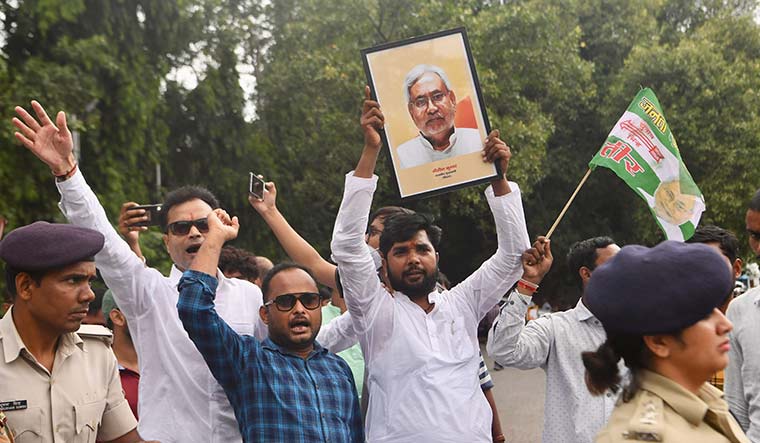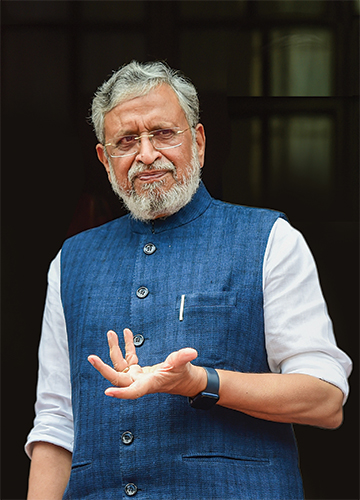On the muggy monsoon evening of July 26, 2017, Bihar Chief Minister Nitish Kumar called his ally, the Rashtriya Janata Dal president Lalu Prasad. He told Lalu that he was calling him for the last time and was going to resign as chief minister and sever ties with the RJD.
Goodbyes are not permanent, not in politics, and certainly not in Bihar. Last month, Kumar called on Lalu in hospital and offered to foot the medical bills. After the RJD supremo was discharged, an alliance was reforged by the two parties. Kumar had decided to break his Janata Dal (United)’s alliance with the BJP. On August 10, before taking oath as chief minister of Bihar for the eighth time, Kumar once again called his friend-turned-foe-turned-friend to brief him about the details of the pact between their parties.
Both in 2017 and 2022, allies could sense Kumar’s unease, but did not really know whether he would dump them. The key difference is that last time the BJP had offered support, while this time Kumar had sounded out the grand alliance partners.
The BJP and the JD(U) had been drifting apart for some time now. The BJP’s recent national executive meeting in Hyderabad called for targeting opposition parties, particularly the regional ones, for being dynastic and corrupt. The coup by Shiv Sena rebel Eknath Shinde in Maharashtra, which coincided with the meeting, unnerved the regional outfits.
What increased anxiety within the JD(U) was the growing closeness of R.C.P. Singh to the BJP. Singh, who recently quit the JD(U) after falling out with Kumar, was the Union steel minister for a year from July 2021. A former IAS officer, he was brought into politics by Kumar, and was made a Rajya Sabha member and JD(U) president. It is said that Singh negotiated the Union cabinet post without Kumar’s approval. Consequently, the JD(U) did not give Singh a Rajya Sabha ticket in 2022, forcing him to step down as Union minister.
Singh then appeared at the BJP meeting in Hyderabad and was even garlanded, leading to speculation that he had joined the party (denied by the BJP). But, his presence there increased the JD(U)’s mistrust of the BJP. “The BJP was trying to weaken us,” said JD(U) president Lalan Singh. “R.C.P. Singh sided with the BJP, working as its agent. Many BJP leaders had joined the Lok Janshakti Party to contest against us. All these leaders lost and again joined the BJP. Was this alliance dharma? Even Nitish Kumar did not want to be chief minister in 2020, but all these small leaders kept commenting against him.” In 2020, the JD(U) lost 28 assembly seats while the BJP gained 21.
For the RJD, repairing the relationship with the JD(U) was logical as it had been feeling the heat from an aggressive BJP. RJD spokesperson Naval Kishore said the move was logical for the JD(U), too. “Look at all the BJP allies; it has either finished them or is doing so. Be it the PDP, the Akali Dal, the Shiv Sena,” he said. “The Eknath Shinde episode and the way R.C.P. Singh was propped up are omens. Look at the way Chirag Paswan [of the LJP] was propped up. He contested on all seats fought by the JD(U) in 2020.” Interestingly, the JD(U) and the BJP had won the last elections because of their repeated reminders to the people about the lawlessness during Lalu’s tenure.
One key factor which could have led to the problems between the JD(U) and the BJP is that the BJP’s Sushil Kumar Modi was moved to the Rajya Sabha. He was an effective channel between Kumar and the BJP, and it is believed that he was moved because the saffron party wanted to grow in Bihar on its own. But, Modi’s absence caused a breakdown in communication between the parties and led to public barbs against each other.
Sushil Kumar Modi accused Kumar of betrayal. “Amit Shah had called Nitish Kumar to ask for a name for the Union cabinet expansion,” he said. “Nitish gave R.C.P. Singh’s name, and only then was he made Union minister. It is a lie that Singh was inducted without consultation. There have also been allegations that we broke alliances. The Shiv Sena was not our ally. We never broke alliances. The BJP has never betrayed anyone. We made Kumar chief minister five times. We were an ally for 17 years, but he broke away twice.”
This realignment of partners ahead of the 2024 Lok Sabha elections has evoked interest in the opposition space despite the drubbing in the presidential and vice presidential elections. And, as all Bihar’s regional parties have supported the JD(U)-RJD alliance, things will get tougher for the BJP. However, given that the party was already planning expansion in the state, it is both a challenge and an opportunity.
BJP state president Sanjay Jaiswal said Kumar had betrayed the people’s mandate. “When we won in 2020, the mandate was for both the BJP and the JD(U),” he said. “He said he was under pressure, but if something bad happens in the state, should we not raise our voices? There were deaths after illegal liquor consumption.”
Open clashes with the assembly speaker Vijay Kumar Sinha had diminished Kumar’s clout in the alliance. He had to abstain from the assembly for a week till the issue was resolved. Then came the Phulwari Sharif terror module case linked to Prime Minister Narendra Modi’s recent visit to Patna. BJP leaders, including Jaiswal, had come down heavily on the state home department under Kumar.
On the other hand, the alliance between the JD(U) and the RJD is still tenuous. The split in 2017 was bitter, with the RJD accusing Kumar of betrayal, similar to the BJP’s accusation now.
Ideologically, the JD(U) and the RJD are on the same side. Kumar has carved out his vote bank—extremely backward classes and women—through affirmative action. This vote bank came to his rescue when he was faced with anti-incumbency sentiment during the 2020 assembly polls. The RJD’s vote bank, the Yadavs, is largely intact.
Both the JD(U) and the RJD were in favour of a caste census, whereas the BJP was opposed to it. In fact, the RJD had effectively trapped Kumar by mooting the idea of a state-level caste census. Kumar, in his fear of the RJD capitalising on the issue, had readily agreed to it without consulting the BJP leadership. When Kumar announced an all-party meeting to discuss the issue, the BJP questioned his motives.
The ties between the JD(U) and the BJP were strained further when Bihar erupted in protests over the Agniveer recruitment to the military. Kumar remained silent and the protests were directed at the state BJP leaders.
Tejashwi Yadav, who took oath as the deputy chief minister, is seen as a rising star who led his party to a good performance in 2020. That, too, without his father, Lalu Prasad, campaigning. The sentiment of the vocal RJD cadre is that Kumar should hand over the baton to Tejashwi before the next elections in 2025.
While the new alliance benefits Tejashwi’s profile and future, it puts more pressure on brand Nitish. The cyberwing of the JD(U)—the Nitish Sena—called him “Sushasan Babu”; sushasan means good governance. But, the name has not found takers on social media. More worryingly, “Paltu Ram” and “Kursi Kumar” have.
In 2017, Lalu called him Paltu Kumar after Kumar’s political somersault. Kursi Kumar became popular because of Kumar’s amazing skill in political musical chairs game. Now the second longest serving chief minister in India after Naveen Patnaik, Kumar has proved to be a survivor. But, his position has also weakened after every battle.
There is no doubt that he is a master politician who can straddle ideological extremes at his discretion. But, for how long?




